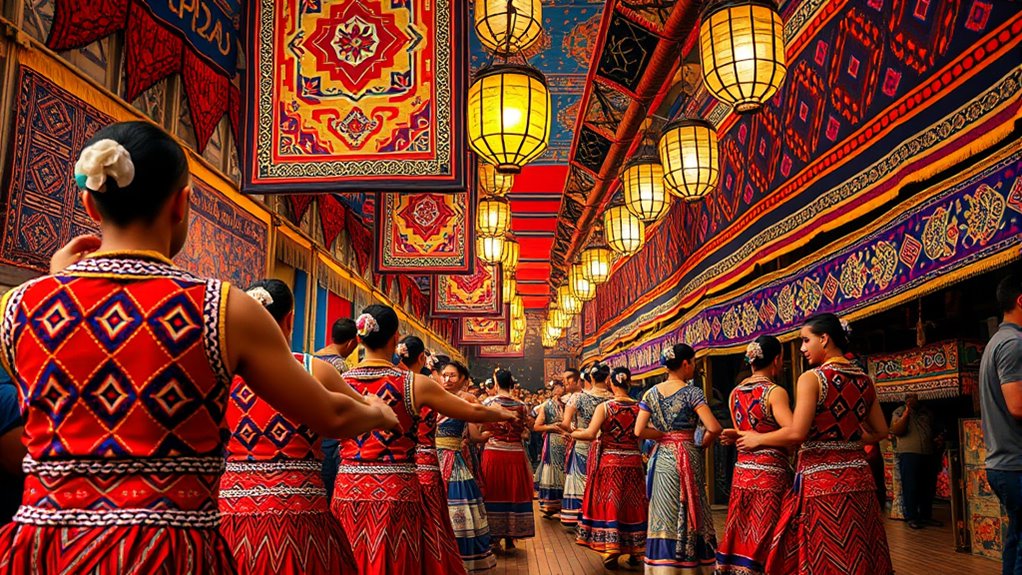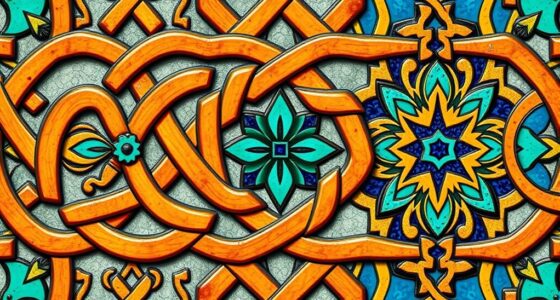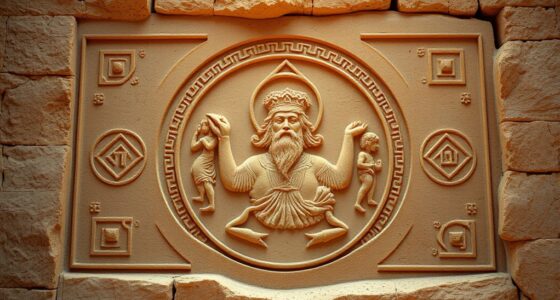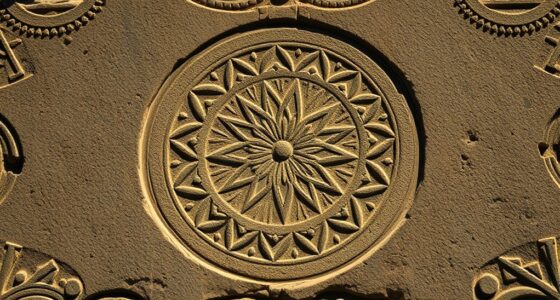Geometric patterns play a essential role in cultural festivals worldwide, adding vibrant visual elements that carry deep symbolic meaning. You’ll see them used in everything from traditional textiles and woven fabrics to intricate mandalas and decorative architectural details. These patterns often represent beliefs, history, or spiritual ideals, helping communities express identity and heritage. If you keep exploring, you’ll discover how these designs connect art, culture, and tradition in fascinating ways.
Key Takeaways
- Geometric patterns symbolize cultural beliefs, history, and spiritual ideas in festivals worldwide.
- Techniques like tessellation and symmetry create visually striking designs with symbolic meanings.
- Patterns encode stories, values, and social status, acting as visual language across different cultures.
- They enhance festival aesthetics, conveying messages of unity, spirituality, and community pride.
- Cultural festivals showcase patterns as powerful symbols that foster identity and cultural continuity.

Geometric patterns play an essential role in enhancing the visual vibrancy of cultural festivals around the world. When you see intricate designs adorning costumes, banners, or architecture, you’re witnessing more than just decoration; you’re observing symbols rich with meaning. These patterns often carry deep symbolic significance, representing beliefs, historical narratives, or spiritual ideas unique to each culture. For example, in Islamic art, geometric motifs embody the infinite nature of Allah, emphasizing unity and order through repeating, symmetrical shapes. In Mexican festivals, vibrant geometric patterns on textiles symbolize cultural identity and ancestral heritage. Recognizing these symbols helps you appreciate how deeply intertwined art and meaning are in festival traditions.
Geometric patterns in festivals symbolize cultural beliefs, history, and spiritual ideas, enriching visual storytelling across traditions worldwide.
As you explore different festivals, you’ll notice that artists employ various artistic techniques to craft these striking patterns. Using methods like tessellation, symmetry, and repetition, artisans create designs that are both mesmerizing and meaningful. In many cases, these techniques require meticulous craftsmanship, with artisans carefully aligning shapes and lines to maintain harmony and balance. For instance, in Indian festivals, intricate mandala patterns are created using precise radial symmetry, symbolizing spiritual completeness. In African celebrations, bold geometric shapes are painted or woven into fabrics, utilizing contrasting colors and sharp angles to evoke strength and community bonds. Understanding these artistic techniques allows you to see the skill and intention behind each design, revealing how the patterns serve both aesthetic and cultural purposes.
The use of geometric patterns in festivals isn’t just about visual appeal; it’s a way to communicate cultural narratives without words. When you observe the repetitive motifs and carefully constructed designs, you’re witnessing a visual language that encodes stories, values, and traditions. These patterns often act as protective symbols, blessings, or markers of social status, transmitting cultural identity across generations. Whether it’s the precise tilework in Spanish festivals or the elaborate woven patterns in Southeast Asian celebrations, each example demonstrates how artistic techniques elevate simple shapes into powerful symbols. This fusion of form and meaning enhances the overall festival experience, making it more than just a celebration—it’s a visual dialogue that connects people to their roots.
In essence, the integration of geometric patterns in cultural festivals underscores their importance as cultural signifiers. They serve as a bridge between the artistic and the symbolic, elevating festival aesthetics while conveying messages of unity, spiritual beliefs, or community pride. When you witness these designs, remember that behind every line and shape lies a story waiting to be understood, a testament to the enduring power of art and symbolism in cultural expression.
Frequently Asked Questions
How Do Geometric Patterns Influence Local Festival Music and Dance?
You’ll notice that geometric patterns influence local festival music and dance by shaping pattern symbolism and dance formations. These patterns guide choreographers, helping dancers follow specific movements that reflect cultural meanings. The intricate designs inspire rhythmic choices, creating a visual harmony with music. As you observe, the interplay of patterns and dance formations deepens the cultural storytelling, making the celebration more vibrant and meaningful.
Are Specific Geometric Motifs Linked to Particular Cultural Beliefs?
You might notice that certain geometric motifs subtly carry symbolic meanings, often tied to cultural beliefs. Pattern symbolism suggests these designs are more than mere decoration; they embody values, stories, and spiritual concepts. Specific motifs are linked to particular cultural beliefs, acting as visual language that preserves traditions and reinforces identity. These intricate patterns serve as a gentle reminder of shared history and collective hopes, weaving deeper layers of meaning into the fabric of the festival.
How Are Geometric Patterns Preserved or Adapted Over Generations?
You preserve geometric patterns through pattern transmission, passing motifs from elders to younger generations via teaching, craft, and storytelling. You adapt motifs by incorporating new influences, blending traditional designs with contemporary styles, which keeps the patterns relevant and vibrant. This process guarantees cultural identity remains strong while allowing flexibility. As a result, your community sustains its artistic heritage, balancing tradition and innovation through continuous motif adaptation and pattern transmission.
Do Geometric Designs Vary Between Rural and Urban Festival Celebrations?
You’ll notice that geometric designs differ between rural and urban festivals, much like handwoven textiles versus sleek city murals. Rural craftsmanship tends to preserve traditional patterns, showcasing intricate, time-honored motifs. Meanwhile, urban design trends influence festival visuals with modern, abstract geometric shapes, reflecting contemporary aesthetics. These variations mirror the cultural blend, where rural areas honor heritage, and cities showcase innovation through evolving geometric artistry.
What Role Do Modern Technologies Play in Creating Festival Geometric Decorations?
Modern technologies like digital design and augmented reality revolutionize how you create festival geometric decorations. You can craft intricate patterns digitally, experimenting with colors and shapes effortlessly. Augmented reality allows you to bring these designs to life, immersing festival-goers in interactive experiences. These tools make it easier to innovate, personalize, and enhance traditional geometric motifs, blending tradition with technology to create mesmerizing visual displays that resonate with contemporary audiences.
Conclusion
So, next time you witness a cultural festival bursting with intricate geometric patterns, remember—you’re witnessing the universe’s most dazzling, mind-blowing art form. These patterns don’t just decorate; they hold the secrets of ancient civilizations, speak a universal language, and turn ordinary celebrations into visual symphonies of awe. By appreciating these designs, you’re stepping into a world where art, culture, and geometry collide in the most spectacular, jaw-dropping spectacle imaginable.









